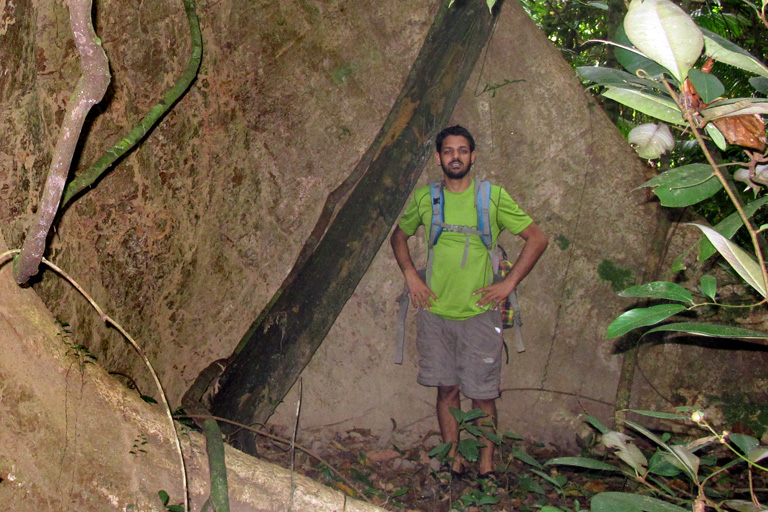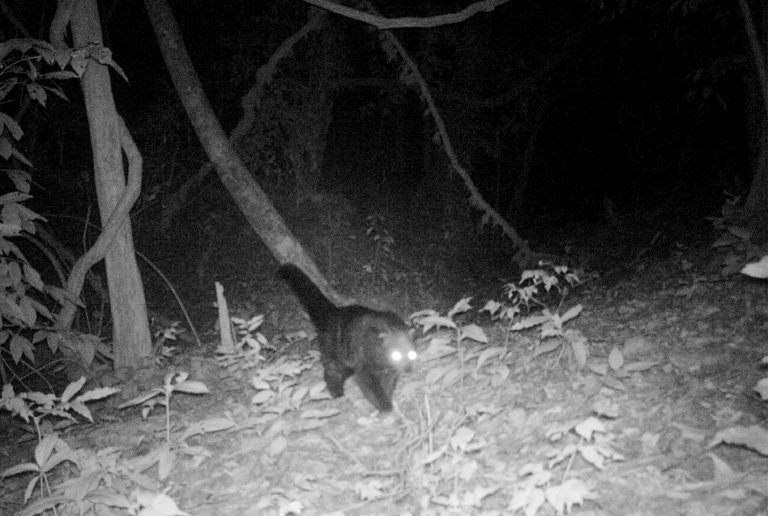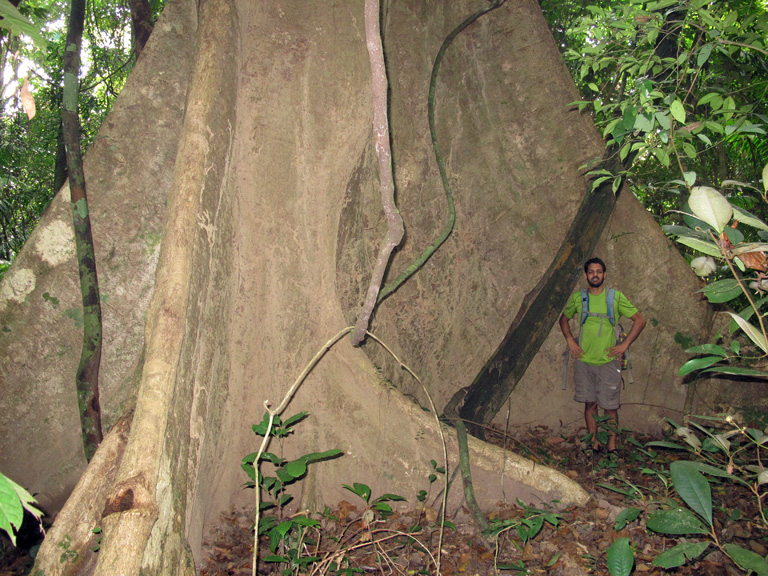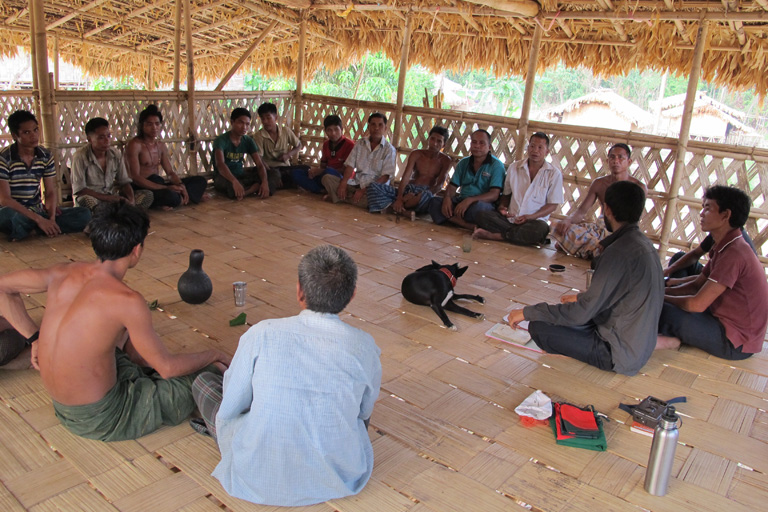- Bordering Myanmar and the Indian states of Tripura and Mizoram, the Chittagong Hill Tracts (CHT) is characterized by semi-evergreen forest that is considered part of the highly endangered Indo-Burma Biodiversity Hotspot.
- Concern for the well-being of these forests and their inhabitants spurred Shahriar Caesar Rahman and associates to this year launch the Creative Conservation Alliance (CCA), a Bangladesh-based non-profit
- CCA is taking an unconventional approach to conservation.
When most people think of Bangladesh’s native ecosystems, the Sundarbans — the world’s largest mangrove forest — are probably the first thing that come to mind. But the Sundarbans aren’t the country’s only wildlife-rich forest ecosystem: dense tropical forests once extended across large expanses of the country, housing tigers, elephants, pangolins, gaur, and numerous other species. Today most of these forests have been cleared for agriculture, firewood and charcoal, and urban areas. Yet some of the forests that survive remain incredibly biodiverse.
Bordering Myanmar on the southeast and the Indian states of Tripura on the north and Mizoram on the east, the Chittagong Hill Tracts (CHT) is one of these areas. Characterized by semi-evergreen forest that is considered part of the highly endangered Indo-Burma Biodiversity Hotspot, CHT is a refuge for at least 26 globally threatened species, making it a critical conservation priority. But conservation efforts in the region have historically been challenged by the very remoteness and political instability that have helped protect it from deforestation seen in other parts of Bangladesh. That protection is now disappearing with the influx of settlers from other regions who are increasingly clearing forests for agriculture, logging trees for timber and firewood, and hunting wildlife. In other words, time is running out for Bangladesh’s last rainforest and its traditional tribes.

Concern for the well-being of these forests and their inhabitants spurred Shahriar Caesar Rahman and associates to last year launch the Creative Conservation Alliance (CCA), a Bangladesh-based non-profit. CCA takes an unconventional approach to conservation, building the capacity of local people to serve as “parabiologists” to help with scientific research and environmental monitoring; setting up elementary schools in exchange for moratoriums on hunting of 15 endangered species; and establishing alternative livelihood programs where local communities earn income from their traditional crafts. The efforts seem to be having an impact: parabiologists are contributing to scientific papers and acting as virtual park guards for an area that lacks legal protection; poaching is declining and literacy increasing in villages that are members of the “Schools for Conservation Program”, and tribal handicrafts are being sold in a boutique in Dhaka.
Rahman talked about these initiatives in a September 2016 interview with Mongabay.com. Rahman was introduced to Mongabay via CCA Director Scott Trageser, who spoke at the annual Association for Tropical Biology and Conservation Asia (ATBC-Asia) chapter meeting in Singapore.

AN INTERVIEW WITH CAESAR RAHMAN
Mongabay.com: What is your background and how did you come to work in the Chittagong Hill Tracts region of Bangladesh?
Shahriar Caesar Rahman: I am a co-founder and the CEO of the Bangladesh-based conservation organization, the Creative Conservation Alliance. I have a keen interest on reptiles and amphibians. I have been working in the Chittagong Hill Tracts for the last five years. Initially, I started a telemetry study of Burmese python in the northeast of Bangladesh. I visited Chittagong Hill Tracts for the first time in 2011 primarily to explore the area to survey for pythons and other herpetofauna in general. While much of my focus then was species-specific, I fell in love with this landscape, wildlife and people, and my idea on conservation has evolved since then. What I started as a personal exploration has advanced into a fully-fledged conservation program.
Mongabay.com: When people think of Bangladesh, probably almost no one thinks of tropical rainforest. Could you tell us about this ecosystem?
Shahriar Caesar Rahman: Bangladesh is a low-lying riverine country and most of the country is floodplain. There are tidal mangrove forests along the coastline-Sundarbans-the largest tract of mangrove forest in the world- lies in the southwest of the country which is the last stronghold of tigers in Bangladesh. Bangladesh had some of the most diverse tropical forests in this region, and unfortunately it has lost most of its natural forest cover. The central and northwestern part of Bangladesh used to have large tract of tropical moist deciduous forest, commonly known as “Sal Forests.” The sal forests have been exhausted to such a great extent now what remains are some small, fragmented patches. In the northeast part of the country we still have some remnant patches of subtropical semi-evergreen forest surrounded by tea, rubber and teak plantation. These remnant patches still harbor many globally threatened species such as Hoolock Gibbon, Phayre’s Leaf Monkey, Elongated Tortoise and even Asian Elephants. In the southeast of Bangladesh, mostly in the Chittagong Hill Tracts, we still have some relatively, larger tracts of tropical semi-evergreen forest.


Mongabay.com: What wildlife is found in this region?
Shahriar Caesar Rahman: CHT falls within the Indo-Burma Biodiversity Hotspot and harbors many globally threatened species. Just within 350 square kilometer forests we have documented over 26 globally threatened species, and many more are yet to be recorded. This area is a hotspot for freshwater turtles and tortoises. We have recorded seven species of turtles and tortoises, including the critically endangered Arakan Forest Turtle, Asian Giant Tortoise and Keeled Box Turtle. We recorded seven species of primates including the globally endangered western Hoolock Gibbon and Phayre’s Leaf Monkey. Seven species of medium to lesser cats, such as, Leopard, Clouded Leopard, Marbled Cat, Asiatic Golden Cat, Fishing Cat. Recently we have documented pugmarks of tigers in our study area which shows the presence of tigers in this landscape. We are yet to verify whether the pugmarks belong to resident population of vagrant individuals, but the locals have mentioned that they have seen tigers breeding within the area. Other notable wildlife include, King Cobra, Reticulated Python, Burmese Python, Chinese pangolin, Binturong, Gaur,Asian Elephant, Sambar, Asiatic Wild Dog/Dhole, Asiatic Black Bear, Sun Bear, Red Serow, Great Hornbill, Wreathed Hornbill, Oriental-pied Hornbill, and many species of little known birds, bats, snakes, lizards and frogs.


Mongabay.com: What are the prospects for this forest? What are the threats?
Shahriar Caesar Rahman: Slash-and-burn agriculture practices, logging, subsistence hunting, and poaching are the major threats to the biodiversity of this forest. The traditional agriculture system practiced by the ethnic people is not sustainable anymore because there are more people in this area now and less land available. As the quality of the soil decreased over time the crop production has decreased and as a result the traditional methods of agriculture don’t even produce enough food for a year. Having left without many options, the ethnic people are forced to move to some of the last remaining patches of old growth forest to cultivate rice. Combined with this factor, the unsustainable harvest of old growth trees, bamboo and rattan by organized groups causing huge damage to the remaining forest of the area.
Having left without many options, ethnic communities are now moving in within protected areas, such as, Sangu Reserve Forest in the southeast of CHT. This is not sustainable for the ethnic communities in the long run because of destruction of the remaining old growth forest, the rivers and streams are drying up fast and as a result there has been a huge water crisis. The ethnic communities living within the Sangu Reserve Forest, and adjacent areas, have very limited access to education, health care and alternative livelihood options. If the government provides them with better access to education, health care, alternative livelihood options then they are willing to move out from the reserve forest.
I think, from a global perspective, there are huge prospects to protect and restore forests of Chittagong Hill Tracts because of its well connectivity to a larger landscape. The Chittagong Hill Tracts are part of a contiguous chain of mountains linking the Himalayas in the north and the Arakan-Yoma Hill Ranges to the south. This landscape is connected to the 237,820 square kilomters Northern Forest Complex—Namdapha—Royal Manas Tiger Conservation Landscape (TCL). Many globally threatened species still persist in this area which has already extirpated from the neighboring Southeast Asian countries. Therefore, if we can protect and restore few forest patches and conserve wildlife within these forests, it would be a tremendous boost for the entire connected landscape. It is still possible to mitigate the threats because the human population density in this area is still manageable.


Mongabay.com: What is your approach to conservation?
Shahriar Caesar Rahman: We are employing a people centric landscape approach to conservation. Many organization focus umbrella species, we are instead focusing on the entire landscape. We are empowering the ethnic community members to take action and conserve their own unique ecosystem and culture by providing them education for their kids, providing economic incentives, such as craft enterprise which provide alternative income sources to reduce their dependency on the forest. By marketing their traditional craft items we are reviving their lost culture. While we believe such bottom-up approach can go a long way in conservation, however we are well aware that political commitment is necessary to ensure the long term survival of this crucial habitat. We are striving to achieve a harmonic balance between top-down and bottom-up approaches.


Mongabay.com: In working with local tribes, you have introduced technology like camera traps and GPS. How is that working? What are they finding?
Shahriar Caesar Rahman: Many of our ethnic parabiologists are former hunters. We empowered them to be guardian of the wildlife they have hunted all their life. The same person who used to go to forest to set traps to kill endangered wildlife are now equipped with camera traps and GPS to learn more about them and to protect them. When you equip them with camera traps, GPS and radio telemetry-it becomes a beautiful fusion of traditional ecological knowledge and modern science. We gave them the camera traps taught them the some basic on how it works. They took the lead and placed the camera traps in locations where they exactly know animals pass by. The results are remarkable. Our team of parabiologists has recorded 26 globally threatened species in our study area, many of which are either recorded first time from the country or thought to be extirpated, such as the Arakan Forest Turtle, Keeled Box Turtle, Asian Giant Tortoise, Gaur, Leopard, Wreathed Hornbill. The survey work culminated in a government report pressuring for the conservation of the area. The findings were also highlighted by international media organizations such as the Guardian.



Mongabay.com: What are some of the challenges working with “parabiologists”?
Shahriar Caesar Rahman: Most of the parabiologists we have been working with have very little to no formal education, yet they are very smart people and they learn the basic concepts quickly. The main challenges are many of them lack punctuality, responsibility and discipline. Sometimes, having a strict monitoring protocol helps but you have to establish close relationship with them so that you can understand them better and motivate them. The qualities I look in a parabiologist are that they are honest, curious and flexible. Finding the right person with these qualities is a challenging task. You have to go through a process of trial and error until you find the right person!
Mongabay.com: Is the government supportive of your efforts?
Shahriar Caesar Rahman: So far the government has been very supportive of our work which is one of the reasons we have achieved so much in so little time. In 2010, government declared a part of the Sangu River upstream in southeastern Chittagong Hill Tracts as Sangu Wildlife Sanctuary for the protection of wildlife. This is an indication that government is genuinely interested in protecting wildlife and its habitat. However, the government has limited resources and there are many other challenges for long term conservation of this amazing forest. But despite all good will and interest it’s really difficult to maintain a coordinated effort for conservation for the government all the time. We are working closely with different Ministries and departments within the government to address and mitigate those challenges.


Mongabay.com: How can people help from abroad?
Shahriar Caesar Rahman: People abroad can help us in many different ways. We run summer tropical field biology workshops every year and where anyone interested can participate. The participants in the workshop help us directly to gather important distributional data on herpetofauna, and other wildlife, and radio tracking threatened Burmese pythons, elongated tortoises and pangolins. So far we have had participants from USA, UK, Canada, Australia, Netherlands, Singapore, Malaysia, and India. It’s great opportunity for students, hobbyists, wildlife photographers and anyone who wants to get new cultural experience.
Also, people abroad can help us by donating directly to our grassroots conservation activities. We have different sponsorship packages where anyone can donate any amount. Even just $80 can support a parabiologist for a month. Without the generous donations of individuals we wouldn’t be able to achieve what we have achieved so far, though engaging with enough private donors remains one of our biggest challenges.



